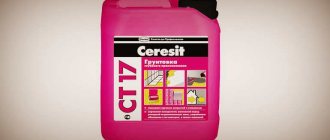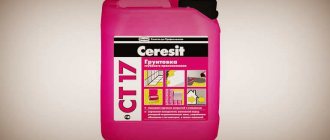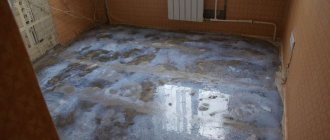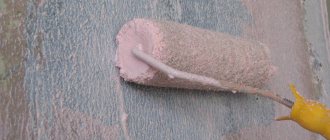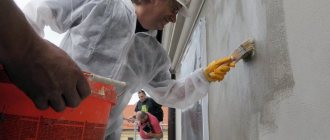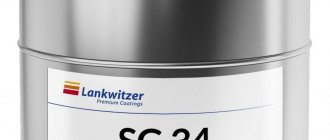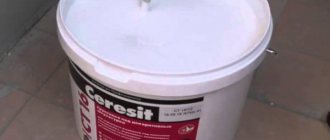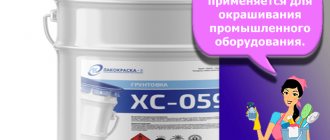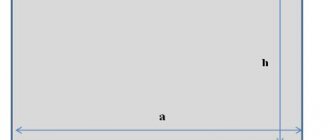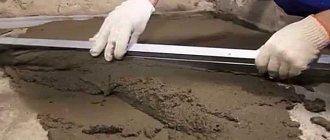Preparation of the base is one of the key phases when creating a beautiful and reliable floor in the apartment. And an important stage that the preparatory work includes is priming the subfloor. This cannot be neglected, since due to the presence of this layer, the service life of the finishing coating can be extended for a long time. Unfortunately, floor primer is still underestimated by many.
Floor primer
Why do you need a primer?
For some reason, many people try to save money on the primer when calculating the budget of funds spent on arranging the floor. However, in reality, priming a concrete or wood subfloor is very important for installing almost any floor covering. Due to the primer layer, it is possible to create a smooth, even surface, and the treated base itself acquires additional strength.
Priming the concrete base
Despite the fact that the primer layer will not be exposed to external environmental factors, its presence will have a beneficial effect on the adhesion of the finishing layer to the base. The duration of operation of the finishing layer, be it tiles or some other material, will largely depend on how well the connection of these layers is. Only a primer can maximize adhesion, that is, increase adhesion.
What is a primer?
The functions of the primer are given below.
- The structure of the rough foundation becomes much stronger. For example, the pores in concrete are sealed, various voids are hidden with soil - a monolithic structure is obtained. In order to improve the quality of the base structure, it is recommended to use deep penetration soils.
- The surface will be additionally dust free. The presence of dust is a factor that significantly affects the quality of adhesion of various materials, and a primer will reduce its negative impact.
The base must be thoroughly cleaned
- The base stops absorbing moisture and liquids. Thanks to the primer layer, the consumption of construction mixtures, adhesives, and paints is significantly reduced.
- The base is additionally protected from moisture. Thanks to the primer, fungus and mold will not grow on the subfloor - they love a humid environment.
- Additional mechanical protection. The screed will crumble and collapse less if it is covered with soil.
Preparing the base for floor screed
On a note! Additional protection from moisture is important for floors in rooms such as gazebos, terraces, balconies, etc.
It is especially important to use a primer before laying floor coverings such as self-leveling flooring, paint, ceramic tiles and others. These materials are particularly demanding in terms of adhesion. The base under linoleum or laminate can also be primed, but only if these coatings will be glued. With other methods of fixing materials, primer for these materials may not be used.
Deep penetration acrylic primer
A primer is also necessary when installing the cement screed itself. It is very important here to ensure a good connection of the hardening mixture with the surface of the floors.
The wooden base also needs to be primed. The primer will significantly reduce the consumption of paints or varnishes, make the surface smoother, and provide additional protection against mold and mildew. Accordingly, the service life of the wooden base will be increased. Also, the primer will get rid of resin stains and protect the tree from insect attack.
Primer increases the service life of the base
Thus, the presence of a primer layer when installing floors is necessary and you should not neglect the use of this material. Even if the budget is very limited, high-quality soil should be included in the estimate in any case. Moreover, it is not that expensive.
Preliminary preparation
It is very important to ensure that there is no dirt, oil, debris or cracks on the floor before applying primer. Hard-to-clean paint or oil can be soaked in solvent or, as a last resort, use a sanding machine if you have one. If a layer of chipboard is applied on top of the soil, then in this case it can be protected from excess moisture, since deformation or complete destruction of the base is possible from exposure to water.
Features of use on a monolith
If the base is monolithic concrete, then there may be a problem with adhesion to the concrete screed, since the monolith is too smooth. In this case, before applying it, use a primer with quartz sand - with its help you can increase the level of adhesion between the materials.
In addition, deep-penetrating primer must be used before screeding also because it can be used to remove all dust from the surface. It is almost impossible to completely remove dust with a vacuum cleaner or broom, while the primer binds all small particles and covers them with a thin film.
What types of primers are there?
The building materials market offers a wide selection of primer mixtures from various manufacturers. All of them can be divided into universal compositions, which can be used in premises for any purpose, and specialized compositions.
Floor primer - classification
Important! For work indoors and outdoors, different specialized compounds are selected. One that will work successfully indoors may fail if used outdoors.
It is best to buy specialized mixtures, since they are maximally adapted for use in specific conditions and are able to better withstand various external negative influences, accordingly, better protecting the surface of the subfloor. Universal soils have rather mediocre performance characteristics and it is better not to make a choice in their favor.
Give preference to a specialized primer
Primers can be sold either ready-to-use or concentrated. Here you need to pay attention to the packaging and follow the recommendations for use.
Important! Concentrated primer without dilution is not recommended.
Also, primer mixtures can be divided into two main categories - these are surface compositions and compositions that penetrate deeply into the structure of the base being treated.
Table. Categories of primer mixtures.
| Category | brief information |
| Surface soils | Usually used on fairly durable surfaces that do not require additional strengthening. The depth of penetration of the composition into the treated surface is only 2 mm. The color of such mixtures is usually milky white. |
| Deep penetration soils | Such compositions are used for loose, rather weak surfaces. The depth of penetration into the thickness of the material is about 6-10 cm. The primer additionally strengthens the surface of the base and significantly increases the adhesion of the surface. The composition mainly contains acrylic polymers, antiseptics and biological additives. This primer is usually used when working with old subfloors. The mixture has a cloudy hue. |
There are also soils that are aimed at protecting the foundation from water penetration. They create a special film on the surface, which will prevent moisture from reaching the subfloor. But such primer mixtures are used only on bases that do not need to be further strengthened. Typically used for treating concrete floors and ceilings.
Primer to protect the floor from fungus and mold
The process of applying primer to the floor
Primers are also divided into several types depending on the components included in the mixture.
Alkyd primers
This type of primer is used to treat surfaces made of wood or metal, but is mainly used for wooden bases. This composition cannot be used for treating concrete screed and drywall. It is usually applied before the surface is painted. The drying time for this composition is about 10-15 hours.
Alkyd primer
Applying an alkyd primer to a plank floor
An alkyd primer can make the surface of a wooden base somewhat loose, so that, for example, when pouring a screed, the cement composition firmly adheres to the wood - the connection of the two materials will be as strong and reliable as possible. Also, such soil will protect the tree from rotting, exposure to parasites, and mold development.
Alkyd primer is suitable for processing OSB
Acrylic primer
This is perhaps the most popular type of primer mixtures, since compositions belonging to this category can be used on any surface. When processing a concrete screed, its surface receives maximum adhesion. The mixture does not smell, is diluted with ordinary water, and can also be used when pouring a screed layer. Drying time is 5 hours. Also, compositions in this category can be called emulsion.
Acrylic primer suitable for any substrate
Attention! Acrylic primer cannot be used on dark iron, because it can cause rust.
Acrylic primer
Epoxy primer
Concrete bases are usually treated with this type of soil. It is especially recommended to use this composition for surfaces exposed to significant moisture - it can be applied even to a slightly damp base. The primer is chemically resistant and can only be diluted with special solvents. Can be used to create a primer layer before pouring self-leveling compounds or painting screeds.
Epoxy Floor Primer
Primer is applied to the concrete floor
Polystyrene primer
This primer is excellent for treating wooden or plastered surfaces. It is quite toxic and therefore cannot be used in confined spaces where there is no way to ventilate the room. It is also important to follow safety precautions when working with the composition and use personal protective equipment.
Other types of soils
In addition to the primer compositions described above, there are other, less common types of primers.
Table. Less common soil types.
| Type of soil | Description |
| Glypthal | Suitable for processing metal surfaces. Gives additional strength to the base. The composition is used only when carrying out interior work. Drying time for the applied primer is about a day. |
| Perchlorovinyl | Suitable for plastered and brick surfaces. Recommended for outdoor use. May be suitable for treating concrete areas outdoors. Drying time is short and is only 1 hour. |
| Polyvinyl acetate | Can only be used when the base is painted with polyvinyl acetate paint. Can be used on floors of any type and made of any materials. Drying time is only 15 minutes. |
| Shellac | A special primer produced specifically for foundations made of coniferous wood. It is necessary so that the resin from inside the tree cannot escape outside. |
Interestingly, you can prepare the soil yourself - this option is suitable for those who are used to saving money. Most often, a deeply penetrating primer mixture is made based on PVA glue.
Primer for concrete
Priming process
Choosing quality material is the key to success. However, it is also important to understand how to properly prime the floor, so that later screeding will be simple and convenient. Before priming, carefully prepare the floor surface. It is best to treat it with a special industrial vacuum cleaner - it can clean the surface very well. If it is not there, then it is recommended to use a regular vacuum cleaner or broom.
To make the process as easy as possible, it is best to purchase a special container before priming. You won’t need a lot of money to buy it, but with its help you can do everything much faster.
To apply concrete impregnation, you can use a roller or a regular brush. It is very important to take care of protecting your hands, body and eyes. This material is very sticky, it eats into the skin and can cause irritation. To obtain a high-quality result, the primer should be applied evenly; it is very important to treat all areas.
Basically, all recommendations for this process are given by the manufacturer; if you follow these rules, then there will be no problems. It can take 4 to 12 hours for the solution to dry completely, after which a second coat is usually applied. And only when the floor hardens and a film forms on it, a screed is made.
Primers for concrete floors
The base, made of concrete, is a rather porous surface, so it requires the use of certain compounds. Concrete itself has low adhesion, so it is especially important to treat it with a primer, which will increase the adhesion between the base and the finishing coating and reduce the cost of paints, varnishes, adhesives and other products.
Most often, polymer soils containing quartz sand are used for priming concrete. Thanks to the product, the roughness of the concrete surface will increase significantly, which means that adhesion will also increase. Polyurethane or epoxy primers are also often used, but they are recommended for use in rooms where the floors experience significant mechanical stress.
Primer before screed for concrete floors
On a note! Epoxy primer is the best option for covering subfloors inside workshops and various industrial premises.
For treating concrete floors, it is recommended to use the Betonkontakt primer. In its properties, the composition resembles polymer primers; it contains quartz sand and significantly increases adhesion. Another advantage of Betonkontakt is the extension of the operational life of the foundation.
Floor primer "Betonkontakt"
Repairing a joint in a concrete floor using a primer
Rating of the best brands
The most popular brands that produce high-quality primers include:
- “Prospectors” - the composition is capable of filling microscopic pores and cracks. It contains quartz sand, which significantly increases the adhesion characteristics of the base to the finishing material. The composition can be used for external and internal work.
- "Ceresit" - the company has been known on the market for about 100 years. It produces sought-after high-quality products. Primers have a water-dispersion base. They use synthetic resins as the main component.
- "Optimist" - the manufacturer offers primers for exterior and interior use. They are produced in the form of solutions of fine latex with the addition of quartz sand, antiseptic components, and modifying additives. The composition can be used for application to coatings in rooms with high humidity. It has leveling properties and increases the degree of adhesion.
- "Tex" is a universal product that can penetrate porous surfaces to a depth of 6 millimeters. Due to its good absorbent properties, the primer can be used for external and internal work.
How to choose a primer
The choice of primer is not as difficult as it might seem at first glance due to the large number of its varieties. The decisive factor will be the type of material from which the subfloor is made. For example, to prime a concrete surface, it is recommended to purchase epoxy or acrylic primers. If surfaces will be primed in rooms with high humidity or those that do not have heating, then a composition that contains water-repellent additives is selected. For bases made of wood, be it even chipboard or OSB, a special mixture is used that has the ability to penetrate deeply. These can be alkyd primers, glyphthalic, polystyrene and acrylic. Varnished floors are treated with transparent compounds that can highlight the structure of the wood. And opaque compounds are used to treat the floor for painting.
Primer "Universum"
How to prime a concrete floor
To lay tiles, it is necessary to choose a soil that provides low suction of the base. This is important so that it does not draw water out of the adhesive solutions used.
Prices for universal primer “Prospectors”
universal primer prospectors
In general, a good primer for a concrete surface should have the following properties:
- have the property of deep penetration;
- lay flat;
- after treating the surface, a water-repellent film should form on it;
- the soil should reduce the consumption of other materials.
Various types and types of primers
Table. Soil consumption depending on the manufacturer.
| Name | Packaging volume, kg | Dimensions of the treated surface, sq. m. | Consumption, kg/sq.m. |
| Phoenix | 20 | 67-100 | 0,2-0,3 |
| Ceresit CT 19 | 15 | 20-50 | 0,2-0,5 |
| Stenotek small | 20 | 67 | 0,3 |
| Stenotek large | 20 | 67 | 0,3 |
| Feidal | 20 | 100 | 0,2 |
| Prospectors | 20 | 67 | 0,2-0,3 |
Prices for primer "Ceresit ST19"
primer ceresit st19
Video - Types of primers
Preparation of the solution
The manufacturer's recommendations are the main ones when preparing the solution. There is no need to invent anything, everything is written on the packaging. The best result is achieved at the proper temperature - from 5 to 30 degrees Celsius - and an air humidity level of 70-75%.
Substance consumption
Typically, on a flat, smooth floor, 1-2 kg of mixture per 10 m2 is spent. On porous, rough surfaces the consumption is many times higher. It’s worth remembering here that you can’t get by with just one layer:
- for wooden flooring with an area of 3-10 m2, one kilogram of primer is enough for 1 layer;
- a mixture with high penetration is consumed at the rate of 1 kg per 7 m2 of floor;
- average consumption of universal mixtures - kilogram per 15 m2;
- Water-based primers are consumed on average less than others - 1 kg per 10 m2;
- adhesive compounds - 1 kg per 3-10 m2.
Before buying material, we look at the condition and quality of the work area. If the floor is very porous and rough, it is better to take 2-3 bags instead of one (you will have to prime in 2-3 layers). A supply will always come in handy. Masters always adjust the purchase weight of mixtures upward by 10%.
How to divorce
If the primer is sold in an already diluted state, the contents of the jar must be stirred well before use. Particles of substance suspended in the thickness of the solution eventually settle to the bottom, making the lower layer thicker, down to sediment. Stirring will evenly distribute the entire contents of the container. A construction mixer or a drill with an appropriate attachment will do the job better. Mixing by hand is also an option in the absence of power tools.
Dry mixtures or concentrated solutions should be diluted:
- one-component primers - water, solvent, drying oil;
- two-component compositions are mixed in a certain order. An hour before work, add the hardener, then the thinner. In what proportions, the instructions say. Stir thoroughly with a drill at low speeds (300-400 rpm);
- alkyd primers are diluted with solvents or solvents (No. 649,650) one to one;
- a water-dispersed floor primer is first mixed in a factory container, then the required volume is poured into a prepared bucket and mixed with water until the proper viscosity is obtained;
- dry water-soluble mixtures are diluted with water 1:4.
There is no need to dilute a lot at once. You should count on the amount that will be consumed during work in the next few hours. Being diluted for a long time, the primer thickens, dries out, and loses its properties. An important point: do not forget to pass the prepared solution through a sieve. It is possible that there are solid particles of the substance left in it, we are getting rid of them.
Applying primer to the floor
Working with any type of primer is easy. The entire application stage can be described in just a few steps.
How to apply primers to floors
Step 1. The rough base is prepared for applying a layer of soil. First of all, if it is raw, it needs to be well dried. Then all construction debris, dirt, and dust are removed from the surface. All oil stains are degreased and paint stains are removed. If necessary, the surface is polished with a grinding machine. Dust and dirt are removed again. A construction vacuum cleaner is usually used to remove dust from the surface. In some cases, wet cleaning and drying of the base again may be necessary.
First the base is prepared
Step 2. In accordance with the instructions on the package, the mixture is prepared, if necessary (ready-to-use primers are also available for sale). All components are mixed in one container and mixed thoroughly.
Preparation of the primer mixture
Step 3. Using a roller, apply the primer to the prepared base until dust settles on it again. The roller first moves parallel to any wall, and then perpendicular to it - this application will be of the highest quality.
Applying primer to the base
Primer application process
Step 4. All corners and joints between the floor and walls are carefully coated. Do not skip pieces of the surface or apply too much primer at once. Application should be even.
The primer must be applied evenly
Step 5. The primer is applied to the entire surface of the subfloor. After this, it is recommended to let it dry and apply another layer of primer.
How to properly prime a concrete floor
On a note! You can apply the primer not only with a roller, but also with a long-handled brush.
Why do you need to prime?
A deep-penetrating primer is a necessity for cement or sand screeds, as well as cellular concrete. With its help you can achieve the following results:
- bind dust and any remaining dirt;
- strengthen the coating surface;
- minimize the absorbency of the coating;
- create a high level of grip;
- achieve an antiseptic effect.
Any material that is applied over the primer will not dry too quickly, which means it will become quite hard and durable. If repair work is carried out by non-professionals, there is a high risk of air bubbles or the material becoming saturated with excess moisture. That is why a primer is applied to the floor surface - with its help all these problems can be avoided.
Conclusion
Using the information in this review, you can easily select a floor primer and apply it well. The video in this article will help you understand the topic even better, and if you don’t understand anything, write questions in the comments at the bottom of the page.
Did you like the article? Subscribe to our Yandex.Zen channel
February 6, 2022
Floors, Construction Chemicals, Dry building mixtures
If you want to express gratitude, add a clarification or objection, or ask the author something, add a comment or say thank you!
